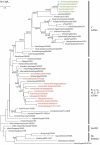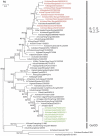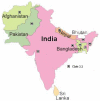Avian influenza (H5N1) virus of clade 2.3.2 in domestic poultry in India
- PMID: 22363750
- PMCID: PMC3282738
- DOI: 10.1371/journal.pone.0031844
Avian influenza (H5N1) virus of clade 2.3.2 in domestic poultry in India
Abstract
South Asia has experienced regular outbreaks of H5N1 avian influenza virus since its first detection in India and Pakistan in February, 2006. Till 2009, the outbreaks in this region were due to clade 2.2 H5N1 virus. In 2010, Nepal reported the first outbreak of clade 2.3.2 virus in South Asia. In February 2011, two outbreaks of H5N1 virus were reported in the State of Tripura in India. The antigenic and genetic analyses of seven H5N1 viruses isolated during these outbreaks were carried out. Antigenic analysis confirmed 64 to 256-fold reduction in cross reactivity compared with clade 2.2 viruses. The intravenous pathogenicity index of the isolates ranged from 2.80-2.95 indicating high pathogenicity to chickens. Sequencing of all the eight gene-segments of seven H5N1 viruses isolated in these outbreaks was carried out. The predicted amino acid sequence analysis revealed high pathogenicity to chickens and susceptibility to the antivirals, amantadine and oseltamivir. Phylogenetic analyses indicated that these viruses belong to clade 2.3.2.1 and were distinct to the clade 2.3.2.1 viruses isolated in Nepal. Identification of new clade 2.3.2 H5N1 viruses in South Asia is reminiscent of the introduction of clade 2.2 viruses in this region in 2006/7. It is now important to monitor whether the clade 2.3.2.1 is replacing clade 2.2 in this region or co-circulating with it. Continued co-circulation of various subclades of the H5N1 virus which are more adapted to land based poultry in a highly populated region such as South Asia increases the risk of evolution of pandemic H5N1 strains.
Conflict of interest statement
Figures





References
-
- Li KS, Guan Y, Wang J, Smith GJ, Xu KM, et al. Genesis of a highly pathogenic and potentially pandemic H5N1 influenza virus in eastern Asia. Nature. 2004;430:209–213. - PubMed
-
- World Health Organization/World Organisation for Animal Health/Food and Agriculture Organization H5N1 Evolution Working Group. Toward a unified nomenclature system for highly pathogenic avian influenza virus (H5N1) [conference summary]. 2008. Emerg Infect Dis. Jul [16.07.2011]. Available from http://www.cdc.gov/EID/content/14/7/e1.htm DOI: 10.3201/eid1407.071681.
Publication types
MeSH terms
Substances
Associated data
- Actions
- Actions
- Actions
- Actions
- Actions
- Actions
- Actions
- Actions
- Actions
- Actions
- Actions
- Actions
- Actions
- Actions
- Actions
- Actions
- Actions
- Actions
- Actions
- Actions
- Actions
- Actions
- Actions
- Actions
- Actions
- Actions
- Actions
- Actions
- Actions
- Actions
- Actions
- Actions
- Actions
- Actions
- Actions
- Actions
- Actions
- Actions
- Actions
- Actions
- Actions
- Actions
- Actions
- Actions
- Actions
- Actions
- Actions
- Actions
- Actions
- Actions
- Actions
- Actions
- Actions
- Actions
- Actions
- Actions
Grants and funding
LinkOut - more resources
Full Text Sources
Medical

